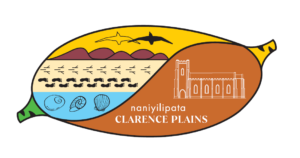You will be walking on the land of the Mumirimina people who called the area naniyilipata*. Their homeland comprised the eastern shore of the River Derwent, extending from the Jordan River to South Arm, and eastwards from the Derwent to Pitt Water and Coal River.
*Names of places in palawa kani, the language of Tasmanian Aborigines, are used with approval of the Tasmanian Aboriginal Centre
Starting at St Matthews Church on North Parade in Rokeby, the trail visits historic sites and natural areas around Clarence Plains. There are 14 interpretive signs providing insight into the history of one of the earliest colonised parts of Tasmania, with settlers arriving from Norfolk Island in 1808.
- St Matthews Church & cemetery
- Life on the Green
- Historic cemetery
- Rokeby Aflame
- The Percy’s Legacy
- The Nutshell
- Norfolk Islanders
- School Days
- Village entrance (Old Watchhouse)
- Mumirimina people
- Dual heritage
- Prominent Houses
- Between the hills and the bay
- Life on the Bay (Rokeby Beach)
The trail was developed by the Tranmere and Clarence Plains Land and Coastcare group and was based on the Centenary of Federation Old Rokeby Historic Trail (link to Clarence Plains Historic Trail | tacplaci)

Activities
- Walking
Warning: Persons using this historic trail do so at their own risk. Many trail sites are privately owned, so please respect that privacy.
More about Clarence Plains
Clarence Plains has always been important both for its Aboriginal and European heritage. This area, called Nannyeleebata, was valued greatly by its traditional owners for the land itself, its birds, animals, the natural vegetation, the shoreline with its major harvests of seafoods, and the landscape within which all this was held.
In 1808, the area named by John Hayes in his expedition of 1793 was to get a new type of land manager. Settlers from Norfolk Island, some of whom had been “freed from servitude” after their comparatively small crimes in England, were granted land in what was thought to be, correctly, a rich agricultural area.
All were to make their mark, both in the provision of food for the new colony, and in developing a community which has lasted and grown over the years. The early influence of the Church in the person of the gregarious Colonial Chaplain Robert Knopwood meant that schools came to the area as early as 1820.
In this open area of country, sheltered by wooded hills, with ready access to Ralph’s Bay, with a then permanent rivulet, Rokeby village grew. By 1866 there were 180 inhabitants in the township, surrounded by pastoral and agricultural properties.
With grand mansions, working farms, humble cottages, schools, inns and places of worship, outdoor activities of cricket, horse races and ploughing matches, Rokeby continued its pleasant and peaceful existence. The semaphore and steam ferries had improved the links with Hobart, and, at Federation, life was good.
Then, the triple disasters of war, depression and fire struck. Rokeby was no longer a prosperous village. Out of disaster came change. In 1942, after Japan entered the war, a power supply was rushed through to Fort Direction and many Rokeby housewives learnt the joy of an electric iron. A sealed main road followed in the ’50s, and after the disastrous bushfires of 1967, mains water, sewerage, public telephones and a Rural Fire Brigade came along.
In the 1970s the Department of Housing, added to the small private housing estates, by developing the Rokeby Grange and Clarendon Vale Estates, introducing the interactive Radburn design in Rokeby. Schools expanded with the suburbs, as did the facilities of shops, church, medical and community centres, and parklands.